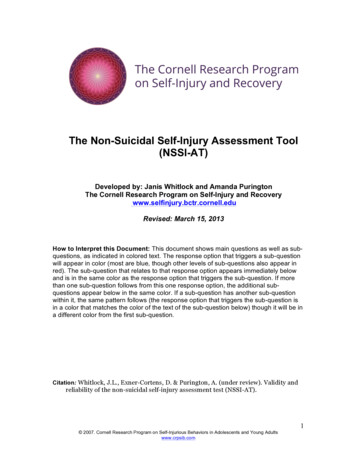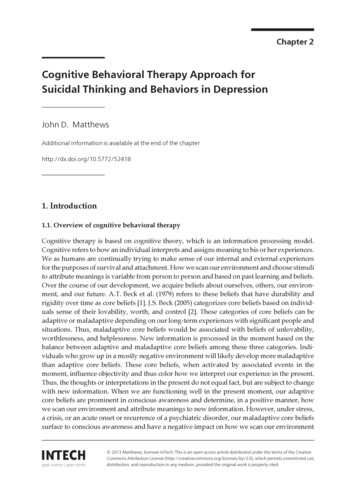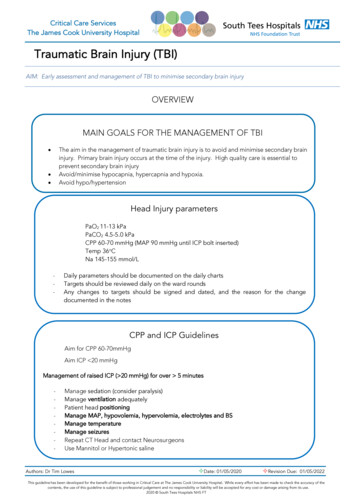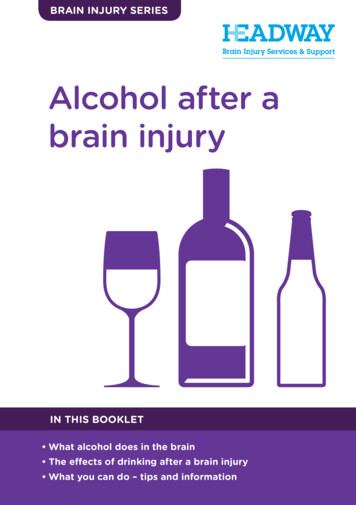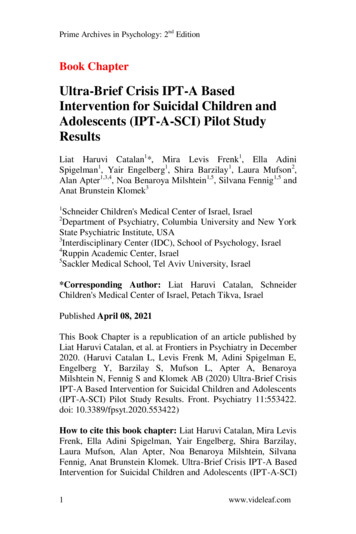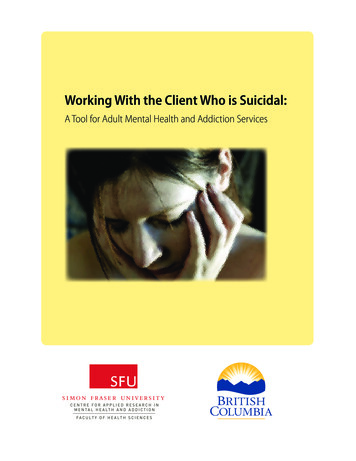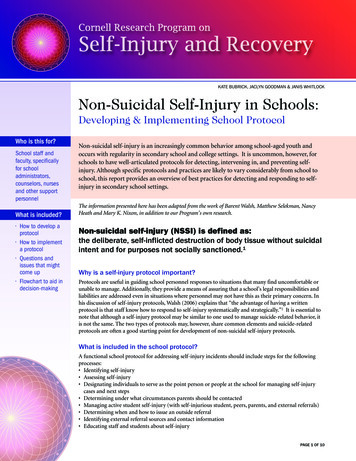
Transcription
Kate BuBricK, Jaclyn Goodman & Janis WhitlocKNon-Suicidal Self-Injury in Schools:Developing & Implementing School ProtocolWho is this for?School staff andfaculty, specificallyfor schooladministrators,counselors, nursesand other supportpersonnelWhat is included? How to develop aprotocol How to implementa protocol Questions andissues that mightcome up Flowchart to aid indecision-makingNon-suicidal self-injury is an increasingly common behavior among school-aged youth andoccurs with regularity in secondary school and college settings. It is uncommon, however, forschools to have well-articulated protocols for detecting, intervening in, and preventing selfinjury. Although specific protocols and practices are likely to vary considerably from school toschool, this report provides an overview of best practices for detecting and responding to selfinjury in secondary school settings.The information presented here has been adapted from the work of Barent Walsh, Matthew Selekman, NancyHeath and Mary K. Nixon, in addition to our Program’s own research.Non-suicidal self-injury (NSSI) is defined as:the deliberate, self-inflicted destruction of body tissue without suicidalintent and for purposes not socially sanctioned.1Why is a self-injury protocol important?Protocols are useful in guiding school personnel responses to situations that many find uncomfortable orunable to manage. Additionally, they provide a means of assuring that a school’s legal responsibilities andliabilities are addressed even in situations where personnel may not have this as their primary concern. Inhis discussion of self-injury protocols, Walsh (2006) explains that “the advantage of having a writtenprotocol is that staff know how to respond to self-injury systematically and strategically.”2 It is essential tonote that although a self-injury protocol may be similar to one used to manage suicide-related behavior, itis not the same. The two types of protocols may, however, share common elements and suicide-relatedprotocols are often a good starting point for development of non-suicidal self-injury protocols.What is included in the school protocol?A functional school protocol for addressing self-injury incidents should include steps for the followingprocesses: Identifying self-injury Assessing self-injury Designating individuals to serve as the point person or people at the school for managing self-injurycases and next steps Determining under what circumstances parents should be contacted Managing active student self-injury (with self-injurious student, peers, parents, and external referrals) Determining when and how to issue an outside referral Identifying external referral sources and contact information Educating staff and students about self-injuryPAGE 1 of 10
Developing a ProtocolWhat is the first step?Responsibility for developing a self-injury protocol most often resides with the school crisis team. If a school does not have acrisis team in place, the first step would be to assemble a team of diverse individuals (typically some combination of guidancecounselors, nurses, school social workers, school psychologists, administrators and/or teachers) best positioned to address issuesrelated to detecting and managing self-injurious students. It is also important to identify a point person from this team to serveas the main liaison between the student, his/her parents, and the school. The crisis team should seek in-depth training fromlocal self-injury or mental health experts. If this training is unavailable locally, the crisis team should look to nationalorganizations such as S.A.F.E. Alternatives (www.selfinjury.com), The Bridge (www.thebridgetraininginstitute.org) or ourproject (www.crpsib.com) for more information. They should also be tasked with the development of strategies for providinggeneral education about self-injury for school staff and faculty.What does the crisis team/point person do? The crisis team/point person (or both) is responsible for: Responding to any disclosures of self-injury. They also serve as a resource for faculty or staff who may suspect a student isinjuring but do not know for sure. Making contact with the student and directing him or her to the nurse for an assessment and care of wounds. Assuring that a self-injurious student is assessed for suicidality at the point of identification and later as indicated bysymptom changes. Acting as a liaison between the student, parents, affected faculty/staff and peers, and outside referral agents associated withthe student as a result of the disclosure. Establishing a productive and supportive relationship with the self-injurious student or finding someone else who can be inthis role.In order for the crisis team or point person to operate effectively, it is important for faculty and staff to refer all suspected orconfirmed self-injury cases directly to the crisis team or point person.Who should be trained in self-injury protocol?All teachers and members of the school staff, from janitors to administrators, should be trained in self-injury protocol. Studentsshould not be included in this education session (unless schools have designated student mental health teams composed ofstudents not at risk for self-injury or related behaviors).What should be part of the staff training?The most important part of staff training is learning how to identify signs and symptoms of self-injury. Staff must be able torecognize the full range of self-injury behaviors. They also need to know what is not self-injury, such as body modification liketattoos and piercings. (Note: Individuals practicing extreme body modification may well be doing so with self-injurious intent.While subtle assessment can be useful in these cases, it would not be appropriate to pull them aside for formal assessmentwithout additional cause for concern.) It is also imperative that staff members are trained to recognize the difference betweenself-injury and suicidal behavior, and to be aware of the conditions under which self-injury requires immediate attention, suchas severe wounds that need stitches or other medical care. Staff should be aware of the designated point person for managingself-injury on campus. Although the designated point person may well be the individual to first initiate conversation with thestudent, all staff should be trained to comfortably respond to students who disclose self-injury. Learning how to respond withwhat Dr. Barent Walsh calls “respectful curiosity” and how to keep the door open for conversation with a student who denies orshuts down conversation is an important skill for anyone who may be in contact with self-injurious students. For more generalinformation about self-injury, please see the factsheet “What is self-injury?” (http://crpsib.com/factsheet aboutsi.asp)PAGE 2 of 10
A person who engages in self-injury has a DIFFERENT INTENT than a person engaging in suicide-relatedbehaviors. While self-injury is a symptom of distress, it is in and of itself not a suicidal act, as it is mostoften used as a means of coping with stress, not ending life. For more information on the differencesbetween self-injury and suicidal behavior, please see the “About Self-Injury” section on the CornellResearch Program on Self-Injurious Behavior website at: http://www.crpsib.com/whatissi.aspSomeone who displays respectful curiosity is not just concerned about making a problem go away butrather with understanding the problem.3 Examples of questions showing respectful curiosity include: "How does self-injuring make you feel better?” “What kinds of situations or types of things make you want to injure?” “When did you begin injuring and why?” “What role does self-injury play in your life right now?”Protocol in ActionIdentifying self-injuryHow is self-injury detected?There are several means through which a school staff person might discover that a student is self-injuring. A student could selfdisclose that he or she is self-injuring. Or, a peer might notify a staff member of another student’s self-injurious behavior. Inother cases, a teacher, counselor or staff member might first notice signs and symptoms suggesting that a student is selfinjuring.Signs and symptoms of self-injury are sometimes absent or easy to miss. Arms, hands, and forearms opposite the dominanthand are common areas for injury and often bear the tell-tale signs of self-injury history (e.g., a right-handed person will ofteninjure his/her left arm). However, evidence of self-injurious acts can and do appear anywhere on the body. Other signs include: Inappropriate dress for season (consistently wearing long sleeves or pants in warm weather) Constant use of wrist bands/coverings, unwillingness to participate in events/activities which require less body coverage (suchas swimming or gym class) Frequent bandages, odd/unexplainable paraphernalia (e.g., razor blades or other implements which could be used to cut orpound) Heightened signs of depression or anxiety Unexplained burns, cuts, scars, or other clusters of similar markings on the skin4It is not uncommon for individuals who self-injure to offer stories which seem implausible or which may explain one, but notall, physical indicators such as “It happened while I was playing with my kitten.” If the individual says that he or she is not selfinjuring or evades the question, do not push – it is important to respect someone’s right to privacy. You can, however, keep thedoor open, by saying, “Okay, well if you ever want to talk about anything, I am available.” Stay connected and look for otheropportunities to ask – particularly if there is continuing evidence that your suspicion is correct.Staff should recognize that self-injury is not confined to certain groups of students, such as “goths” or“emos.” Self-injury is not limited to a particular look or appearance nor is it confined to membership in aparticular social group. See our “Top misconceptions about self-injury” 20misconcepts%20REV.pdf) for more information.5PAGE 3 of 10
What should happen once we know or suspect a student is self-injuring?If a staff member learns or suspects that a student is self-injuring, he or she should contact the designated crisis team or pointperson specifically trained to deal with self-injury. In some cases, someone other than the point person or crisis team memberwill be faced with responding directly to a self-injury disclosure or incident. Regardless of the individual, it is critical that thefirst response to self-injury disclosure be emotionally calm, kind, and non-judgmental (see the use of "I statements" below). It isalso important that first responders be honest with the student about the school protocol requiring them to share theirknowledge of self-injury with the designated point person. They should assure the student, however, that although it is likelythat the designated point person will be in touch with the student, all information shared about the student’s self-injury isstrictly confidential. In schools with protocols which include the self-injurious student as a collaborator in deciding a course ofaction once self-injury is disclosed, students will also benefit from knowing that they will have a say in what happens after thedesignated point person is notified.Use of “I” statements such as “I’m concerned about you and want to be sure you have the support youneed,” or “I’m worried about you. I’ve seen these scars on yours arms and I think you might be hurtingyourself. If you are, I want you to know that you can talk to me about it. If you can’t talk to me about it, Ihope you will find someone else you trust to talk to” demonstrate concern without judgment and mayhelp to put a self-injurious student at greater ease.Assessing self-injury Who should assess?Assessment of student needs and next steps will require input from the designated point person/team as well as from the nurseif there are open wounds that require attention. Unless the student is in obvious emotional crisis, kind and calm attention toassuring that all physical wounds are treated should precede additional conversation with the student about the non-physicalaspects of self-injury. The wound severity, implements used, location of the injury and observed number of scars from oldwounds can all be noted during treatment and discussed with the designated point person/team when triaging next steps.Asking straightforward medically-focused questions at this stage may also be appropriate if student is calm and willing to share.Questions of value in assessing severity and next steps include: Where on your body do you typically injure? What do you typically use to injure? What do you do to care for the wounds? Have you ever hurt yourself more severely than intended? Have your wounds ever become infected? Have you ever seen a doctor because you were worried about a wound?In addition to informing the nurse about the student’s capacity for self-care, responses to these questions will be useful to thedesignated point person/team when assessing next steps related to parental notification and involvement, school responses andmanagement, and engagement of external referral sources.Should a suicide assessment be conducted?Some students who self-injure may also be suicidal, either during the period in which they are injuring or later in theirdevelopment. While it is uncommon for actively self-injurious students to be suicidal, suicide assessment is warranted –particularly if there is any reason to believe that the student might be actively suicidal. In this case, suicide assessment shouldoccur immediately and, if suicidality is detected, suicide protocols should be followed from this point forward. Note that whilea self-injurious student may not be or have ever been suicidal at the point at which self-injury was detected, the behavior doesserve as a warning sign for some students that suicide may become an option later, especially if the distress underlying selfinjury is not adequately addressed.PAGE 4 of 10
Research suggests that not all self-injury is equally severe. One study documented 3 self-injury classes6:Superficial Low lifetime frequency (fewer than 11 episodes of self-injury) Use forms capable of resulting in largely superficial tissue damage (e.g., scratching or woundinterference) Tend to use relatively few forms of self-injury behaviors This is the least severe level of lethality, however, people falling in this class might be at an increased riskfor suicidal ideation compared to students who do not self-injureBattery/light tissue damage Low lifetime frequency of self-injury (fewer than 11 episodes of self-injury) Use forms capable of resulting in light tissue damage (e.g., small punctures and bruising) Tend to use several forms over time (most serious form used results in light tissue damage) Members of this class are at a higher risk for suicidality, a history of trauma, and disordered eating incomparison to the superficial class and those who do not self-injureChronic/High severity High lifetime frequency of self-injury (greater than 11 incidents) Use forms capable of resulting in high tissue damage (e.g., cutting, ingesting caustic substances, bonebreaking, etc.) Tend to use several forms over time (most serious form used results in high tissue damage) Members of this class are at the highest risk for suicidality, a history of trauma, and disordered eating incomparison to other self-injury classes and non-self-injurers. Members of this group are most likely to fulfill the classic “cutter” stereotype (e.g., they have self-injuryroutines, report some degree of perceived dependence on self-injury, report hurting themselves morethan intended, and report life interference as a result of their self-injury)What next? Ideally, someone from the designated team will have the opportunity to talk to the self-injurious student immediately followingthe physical assessment or soon after. In general, response to self-injury, like many student behaviors at school, is heavilycontext-dependent. Immediate responses to students should be honest and respectful. Collecting basic information about astudent’s self-injury practices and history will be important in determining the need for parental involvement and engagementof outside resources.Overall, questions should aim to assess a) history, b) frequency, c) types of methods used, d) triggers, e) psychological purpose,f) disclosure, g) help seeking and support, and h) past history and current presence of suicidal ideation and/or behaviors.Decisions about next steps can be made based on the outcome of this assessment. In general, students are likely to fall into oneof two risk categories:Low risk studentsStudents with little history of self-injury, a generally manageable amount of external stress, at least some positive coping skills,and some external support are those most likely to be easily managed. Parents may or may not need to be notified in this casedepending on the point person’s confidence that self-injury is transient and not severe enough to cause unintended injury (seethe following section, "Engaging parents," for more information). In these cases, it is important to work with the student tocome up with strategies for handling stress and for checking in with the point person or another on-site trusted adult duringtimes where they began to feel like they may be at risk for self-injury or other unhealthy behaviors. Monitoring studentbehavior through observation, teacher reports, and periodic check-ins is also warranted for a brief time following a self-injuryevent.PAGE 5 of 10
Higher risk studentsStudents with more complicated profiles – those who report frequent or long-standing self-injury practices, who use highlethality methods, and/or who are experiencing chronic internal and external stress with few positive supports or coping skills –are likely to require more aggressive intervention and management. Unless there exists a high likelihood that it will pose anadditional risk to the student, parental involvement will likely be indicated in these cases. It is important to note that studentsshould be engaged as active participants in each step – even in cases where the next obvious step elicits resistance. Unless thestudent is in severe crisis and unable to function (in which case parents need to be contacted immediately) the decision to makeparental contact should be discussed honestly and respectfully with the student.Engaging parentsIdeally, the student should be encouraged to call his or her parents to talk about what occurred. The point person should alsotalk to the parent about the need for a meeting to talk about next steps. The meeting should include the student, parents, andthe point person or crisis team and should be scheduled as soon after the event as possible. In the event that a student isreluctant to contact his or her parents, the crisis team must take responsibility and alert parents that their child might be indanger of harming him or herself in the future.Since state and local laws surrounding student confidentiality and parent disclosure may vary, eachschool’s policy about parental contact will need to be crafted in accordance with these regulations.Parent meetings provide an opportunity for the crisis team to answer questions, address parentalconcerns and dispel any myths about self-injury that the parents might have.It is also recommended that the team provide parents with both community and web-based resources for understanding andeffectively addressing self-injury. Another important goal of the meeting is for the crisis team, parents and student to discusshow to create and maintain a supportive, appropriate environment for the student. Helping parents understand the differencebetween constructive and unhelpful responses to self-injury and related issues will be very important when it is obvious thatparent-child dynamics may be contributing to the behavior.Finally, the point person/crisis team should urge the parents to seek outside counseling and support for their child. Alertingparents to the fact that family therapy can be helpful in situations like these may also be appropriate and help to prime parentsfor more active engagement in their child’s recovery. Having local mental health resources on hand is very helpful and offeringto assist in setting up initial appointments can provide an important aid to families in need.Scheduling a follow-up meeting with parents and student before leaving the initial meeting is also useful. This typically occurs1-2 weeks and no later than 1 month after the school detects a self-injury incident.What are the legal issues surrounding parent notification and self-injury?When the situation is deemed by the point person to require additional intervention, the point person should contact thestudent’s parents or guardians. The American School Counselor Association requires confidentiality between students andcounselors except in event that the student is at risk for harm.7 The literature surrounding self-injury suggests that elementaryor secondary school staff should inform parents about their child’s self-injuring behavior even if it is deemed that the child isnot an immediate threat to himself or herself. In making this decision, the point person should account for all factorssurrounding the student’s situation, not just the severity of the injury. The student should be advised in advance of this andallowed to be present during the conversation.It is the legal responsibility of the school to notify parents of their child’s self-injury. If a parent of a student who is self-injuringdoes not make any effort to seek outside counseling or help for their child, their behavior may be seen as neglectful. The schooldoes have the responsibility to report parental neglect to the local child protection agency.PAGE 6 of 10
What may parents be asked to do?The purpose of involving parents is to ensure that the student will receive care and so that outside referrals to services can bemade. Depending on the circumstances, the parent may be asked to: Initiate outpatient counseling for the child and/or family Agree to having the child receive enhanced academic and/or counseling supports within the school itself Provide releases of information to the school so that the crisis team/point person may communicate with any outsideprofessionals who are assisting the student8How might parents react and what kind of support can be provided?Counselors should expect to see a wide range of reactions from parents. Some parents will respond quickly and favorably, butothers may need more time and help in coping with their own thoughts and feelings.What if parents feel guilty? Parents may think that their child is self-injuring because of something that they did or did not doas a parent. If the parent seems to be struggling with guilt or frustration, it may be helpful to remind them that they can also getcounseling for themselves during this difficult time.What if parents are dismissive about a student’s problem? The school’s role is to encourage the parents to be more responsiveto their child’s needs.What if parents are enraged about a student’s problem? The school’s role is to encourage the parents to try and understandwhat their child might be going through, recognize that their child is suffering, and approach their child from a nonjudgmentalstance.How should we deal with parents that have extreme reactions? The school’s job is to gently suggest that the parents seekoutside counseling for dealing with their adolescent.How can we encourage collaboration? Schools must encourage parents and students to use teachers and staff as resources.What if the parents are absent, lack the financial capital to seek outside help or are unable to act as a resource and advocatefor their child? The school must take initiative and act as an advocate for the student. Here, the crisis team may seek outsideresources for the child. The crisis team may seek solutions to financial barriers preventing the student or family from seekinghelp.While it is important to validate parent’s reactions, certain parental attitudes towards self-injury can promote, trigger ormaintain the behavior.9Helping parents react with a calm, empathetic and comforting demeanor can ease the recovery process.Identifying External Referralsfinding local therapists and counselors to treat adolescents who are self-injuring is a challenge. The S.A.F.E. Alternatives website provides a listing of local therapists (by state) that are trained in self-injury treatment. Thisinformation may be found at http://www.selfinjury.com/referrals therapistreferrals.html If there are not therapists trained in self-injury that are nearby, general guidelines on how to find a therapist can be found athttp://www.selfinjury.com/referrals findatherapist.html Another good resource for finding a local therapist is the listing of State and Provincial Psychological Associations, availablefrom the American Psychological Association. This information can be found at http://www.apa.org/practice/refer.html The crisis team or point person can refer parents to the preface of Matthew Selekman’s book Working With Self-HarmingAdolescents: A Collaborative, Strengths-Based Approach for help in coping with a child’s self-injury.PAGE 7 of 10
Social ContagionWhat is social contagion? How can we identify a social contagion problem in our school?Social contagion refers to the way in which a behavior such as self-injury can spread among members of a group. Socialcontagion is a possibility any time that other students become aware that someone among them is injuring. Dr. Barent Walshnotes that certain behaviors are susceptible to social contagion both because of their power to communicate as well as theprovocative nature of their stigma.10 Sometimes, behaviors can be unintentionally reinforced by people outside of the group,including adults.How can we prevent social contagion and self-injury in schools? To prevent social contagion in schools, staff must reduce communication around self-injury. If a student is injuring, forexample, he or she should be advised not to explicitly talk with other students about engaging in the behavior. Secondly, staffshould help self-injuring students to manage scars and wounds. Visible scars, wounds and cuts should be discouraged.To prevent social contagion of self-injury in schools, students must not be given explicit details about self-injury. This meansconvening a school-wide assembly on the topic is NOT appropriate. However, educating students about signs of distress inthemselves and others, as well as teaching the use of positive coping skills, is appropriate and even suggested. Finally, treatmentof self-injury within schools MUST be done on an individual basis. It is not appropriate to treat self-injury in a group therapysetting.The risk for contagion is increased when high-status or “popular” peers are engaged in self-injury orwhen self-injury is used as a means for students to feel a sense of cohesiveness or belonging to aparticular group.The example below provides reference to how a self-injury protocol may work in areal-life school setting:Amanda is a 15 year old sophomore at City Y’s High School. One day, Tom, her gym teacher, noticesboth older and more recent scratches and scars on Amanda’s forearms and thighs that look like asign of self-injury he learned about in school training sessions.Tom is concerned that Amanda couldbe putting herself in danger by selfinjuring. He contacts Barbara, theschool social worker and designatedself-injury crisis team point person,about his concerns.Barbara and Tom talk about the scarsAmanda has and together determinethat she might be self-injuring. Barbaraassures Tom that she will not reveal himas her source of the referral and willkeep him updated on the course ofaction with Amanda. Since Amanda’sself-injury does not require immediatecare, the nurse need not be contactedimmediately.Soon after their discussion, Barbaraasks to speak with Amanda and letsher know that she’s not in trouble. Intheir one-on-one meeting, Barbara tellsAmanda that it has been brought to herattention that she may be injuringherself. Amanda denies it at first buteventually discloses that she has beeninjuring her forearms and thighs on andoff for 8 months. Amanda says that shecuts herself when she’s angry with hermother, who recently divorced herfather and that her cutting makes herfeel less angry. Barbara asks whether ornot Amanda’s parents know about herself-injury, if anyone else knows, andabout other resources Amanda hasavailable for helping her cope with herfeelings. Based on what Amanda hastold her, Barbara believes that Amandais not in immediate danger but doesbring the case to the crisis team todecide the course of action. Barbaratells Amanda that she would like tohave the nurse take a look at her scarsso that she can be sure that none ofPAGE 8 of 10
her injuries become infected and helpher treat her older scars. Amandaconcedes but asks that no one elseknow about her behavior. Barbara tellsAmanda that she can promise not totalk to any of her peers and will shareinformation with other adults in theschool on a “need to know” basis only.Barbara does tell Amanda that she willneed to consult with the school crisisteam about how to best support her,but reassures Amanda that they willboth be involved in any decisions thatare made about what to do next.The crisis team meets with Amandapresent and decides, based on theinformation available, that Amanda willbest be helped by treatment with alocal psychotherapist who specializesin helping individuals who self-injure.Then Barbara contacts Amanda’sparents, with Amanda present, to makethem aware of the situation andprovide a referral for treatment.Amanda’s mother reacts with shoc
strictly confidential. In schools with protocols which include the self-injurious student as a collaborator in deciding a course of action once self-injury is disclosed, students will also benefit from knowing that they will have a say in what happens after the designated point person is notified. A-- -- )" - '!- )%/,3 #* -#*/' -- --?
